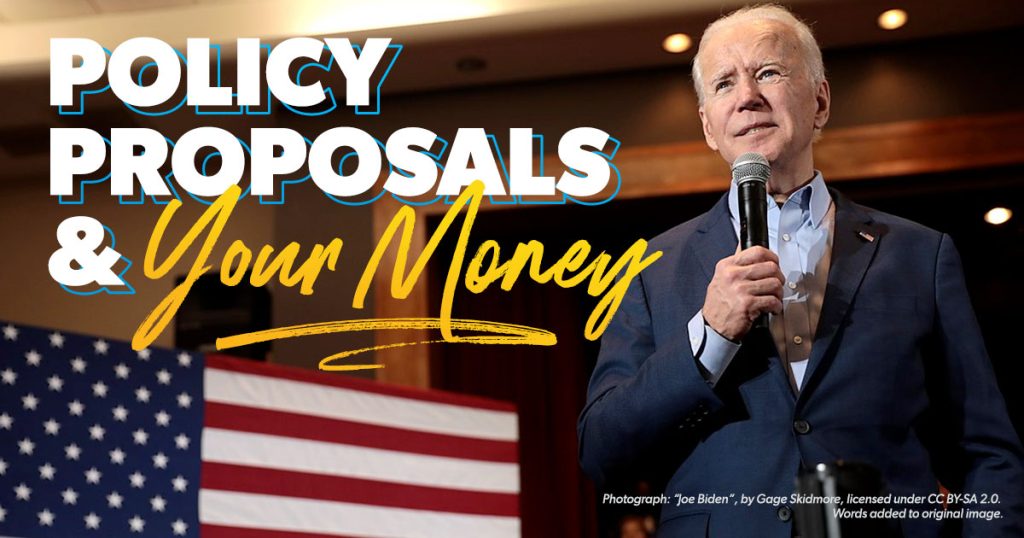Back on January 20, 2021, Joe Biden officially became the 46th president of the United States. And with the new change of administration in the White House came a lot of speculation about what kinds of policies he would put into action.
Whether you have your doubts about this administration or you like seeing a new leader in action—every American wants to know how Joe Biden’s policies could affect them while he’s in office. We’re going to dig into that, but first—let’s get some perspective on a couple of things.
The President Doesn’t Have All the Power
Americans are quick to give the president of the United States too much credit, especially in how much change that one, single person can bring. Sure, the president is the president, but our government was created with a pretty genius system of checks and balances that requires a lot of teamwork to get anything done.
So, yes, even though we’ve already seen Biden use what’s called “executive orders” (64 times to be exact), he’s still got to work with Congress to pass major legislation.1 And you can bet those folks will have a list of changes and proposals of their own that will rework President Biden’s policies if any make it through the gauntlet of committees and approvals. (We’re already seeing this with Biden’s American Families Plan.)
Knowing all that, it’s still important to be in the loop about the changes that could come (and some that already have). That way, you can take advantage of the benefits—or plan for the potential hit.
Let’s dig into the details of a few of the proposals Biden campaigned on and agendas he’s trying to get pushed through that could affect your money the most. We won’t try to hash out whether they’re the right or wrong thing for the country—there are plenty of other people doing that. We’re just going to focus on your finances.
Biden’s Policies for Student Loan Forgiveness
It’s no secret that the $1.58 trillion-plus student loan crisis is a huge burden for millions of Americans.2 And the COVID-19 pandemic didn’t do anything to help that either. Biden, along with other presidential hopefuls, campaigned on promises of student loan forgiveness. And even after being elected, Biden has repeated his commitment to cancel some amount of student loan debt—even calling on Education Secretary Miguel Cardona to research if the president has the ability to cancel student loans.3 But then Biden switched gears and shocked everyone by leaving out student loan forgiveness from his 2022 budget.4 Yep—the plot thickens.
So, how will Joe Biden’s policies apply to student loan debt? It’s still a bit of a mystery, and we’ll have to see how this one plays out during his time in office.
What we know about Biden’s proposal: Just because he left it out of his budget plan for the year doesn’t mean Biden has let go of the idea altogether. We know Biden was a fan of legislation passed in the House last year that offered $10,000 per borrower in student loan forgiveness as part of a coronavirus relief bill. But the bill wasn’t supported by the Republican-controlled Senate.
Even though Biden left student loan forgiveness out of the budget, some Democratic leaders are pushing Biden to cancel as much as $50,000 per borrower and to go around Congress by writing an executive order to get it done.5 But not everyone agrees the president has the power to do that. And the Supreme Court will have something to say about that too.
The fact is, the government already has multiple student loan forgiveness programs, and none of them are all that good at actually forgiving loans anyway.
- The Teacher Loan Forgiveness program is designed to cancel up to $17,500 in federal student loans for teachers. But the requirements are tough to meet and include teaching at low-income schools full time for five academic years.6
- To qualify for the Public Service Loan Forgiveness program, you have to work full time for the government or a nonreligious nonprofit, be on an income-driven repayment plan, and prove that you’ve made all your student loan payments on time for 10 years.7
But who really gets their student loans forgiven anyway? Not many folks. From November 2020 to April 2021, a whopping 98% of applicants for Public Student Loan Forgiveness were turned down. That means only two out of every 100 applicants were approved for the loan forgiveness.8 Yikes!
Our advice: Moral of the story? If you’re banking on your student loans to be wiped clean—don’t. You’ve got two good reasons not to rely on a government plan to solve your student loan debt. One, there’s no way to know if Biden’s student loan debt forgiveness proposal (whatever it ends up being) will ever become a reality. And second, if it does, there’s no way to know what the requirements will be or if the plan will actually be effective.
You know what is effective? You—with the right plan to tackle your student loan debt. Just follow the Baby Steps:
- Start with Baby Step 1: That’s saving $1,000 for a starter emergency fund. With this first step taken care of, you have a cushion to fall back on while you’re paying off your debt. You know, so you don’t get tempted to take on more debt at any point.
- Once that’s done, it’s on to Baby Step 2: Pay off all debt (except the house) using the debt snowball. If your job and income are stable, start throwing as much cash as you can at your debt. Start by paying off the smallest balance and work your way up to the largest, rolling the payment from each paid-off debt into the next one so you’re building momentum the whole time. We call that the debt snowball.
You can also think about refinancing your student loans if it makes sense for you. A better interest rate and shorter term mean those student loans could be out of your life faster than you ever thought possible. Check with the only refi partner we trust to see if refinancing is a good option for you.
Biden’s Policies for Income Taxes
As president, Biden hopes to make a lot of changes to our income tax system with the overall goal of making it more progressive. In political speak, progressive means the more you make, the more you pay in taxes as a percentage of your income. According to the Tax Policy Center, Biden’s plan will raise taxes by $2.4 trillion over the next 10 years (based on numbers provided during his presidential campaign).9
If his plans happen in the way he explained while campaigning, things would look like this in the year 2022:
- Households making between about $50,000–90,000 would get an average tax cut of about $6,700.
- Higher income households ($330,000–790,000) would be hit with an average $98,000 tax increase.
- The top 1% of earners ($790,000 or more) would pay an average of $265,000 more than they do now.10
What we know about Biden’s proposals: Many of Biden’s proposed changes are aimed at families, so a lot of single people and couples without kids on the lower- and middle-income ranges won’t see all the benefits of those changes.11
Child Tax Credit
One of the first changes Biden put in place was increasing the Child Tax Credit. Biden’s policy changed it from the usual maximum of $2,000 to $3,000 for each qualifying child under age 17. Got a little tyke? Your magic number rises to $3,600 for each kiddo under age 6.12
And bonus—this credit is fully refundable. That means if a family’s Child Tax Credit is more than the amount of taxes they owe, they’ll receive a refund for the difference. The current credit is refundable but is limited to 15% of the household’s income that exceeds $2,500.13 (If that seems weirdly complicated to you, that’s because it is.)
So, under the current policy, a family with three children, ages 12, 8 and 5, and a household income of $75,000 a year, would get $6,000. And even with the weird math, they could get a refund for the full amount. Under Biden’s proposal, that same family would get a $9,600 fully refundable credit.
Another interesting thing about the revised Child Tax Credit—you can get half of the refund “up front” in monthly installments from July to December 2021. You’d see the other half of the payment when you file your 2021 tax return next year.
Child and Dependent Care Tax Credit
Joe Biden’s policies in the American Rescue Plan call for expanding the Child and Dependent Care Tax Credit to help families with expenses like day care. Right now, the maximum credit is $3,000 for one qualified dependent ($6,000 for multiple dependents).14 Biden would raise the max to $8,000 ($16,000 for multiple dependents) and increase the maximum reimbursement rate. As it stands now, you can be reimbursed for up to 35% of your qualifying expenses. But under Biden’s plan, you could be reimbursed for up to 50%.15
In real life, that means a family paying $30,000 a year for day care for two kids would see their Child and Dependent Care Tax Credit go from $6,000 to $16,000.
First-Time Homebuyers Tax Credit
Biden is also working to bring back the First-Time Homebuyers Tax Credit, now being called the First-Time Homebuyer Act, that was created during the Great Recession to encourage people to buy homes again. Under his plan, qualifying first-time home buyers would receive a tax credit of up to $15,000 when they purchase a home.16
Our advice: Always take advantage of the deductions and tax credits you qualify for. Really—no one should pay more in taxes than they have to! When it come to the Child Tax Credit, those advance payments from July to December are actually a good way to keep more of your own money in your own pocket during the year. And we’re really big fans of that—but only if it doesn’t create a tax mess for you when it comes time to file your 2021 taxes. You don’t want to take all the credits and then be slapped with a surprise bill at tax time.
With all these tax changes, it’s a good idea to call in the folks who live and breathe this stuff. So if you want your taxes to be squared away the right way, check in with your tax pro. These are the experts who can walk you through any new changes and how they impact your money.
Would Joe Biden’s Policies Actually Raise Taxes?
You might be wondering, How will the government pay for all of this stuff? Here’s the not-so-surprising answer: your taxes. On the other side of all these tax benefits are tax hikes that, like we mentioned before, are aimed at higher-income earners. They’re also aimed at businesses. Here are just a few:
- Tax rates for households making more than $400,000 would increase from 37% to 39.6%.17
- Households that make more than $1 million would see their long-term capital gains (money you make when you sell an asset you’ve owned for more than one year) and qualified dividends (a portion of a company’s profits that is distributed to shareholders) taxed at their ordinary income tax rate of 39.6%, instead of the current 20%.18,19
- The estate and gift tax rate and exemption would go back to 2009 levels, making more gifts and estates fall under the higher tax rate.20 Estate taxes reduce the value of an estate before it’s given to any heirs, and the gift tax applies to gifts of money or property of more than $15,000 in value (Biden would change that to the 2009 level of $13,000).21 And the giver is then responsible for paying the tax on the gift.22
- People making $400,000 or more would see their itemized deduction tax benefit capped at 28%. That means some of those folks wouldn’t get the full advantage of all the deductions they qualify for.23
- The corporate tax rate would rise from 21% to 28% to help pay for some of these proposals—specifically the ones shoved into Biden’s $3.5 trillion infrastructure plan.24 The Biden administration says the tax is mostly for big corporations and that 97% of small-business owners won’t be affected—but the Tax Foundation claims the tax could actually affect about 25% of small businesses.25,26
Our advice: Like we said before, take advantage of all the tax deductions and credits you can. But just keep in mind—these increased tax credits could mean a larger refund for some folks. It sounds fun until you realize that money should be in your pocket (not Uncle Sam’s) all year long.
You may need to adjust your W-4 if these proposals are approved so that you bring home more money in your paycheck and keep your income tax refund as close to zero as possible.
When it comes time to actually file your taxes, any changes that have taken effect could be confusing. For people with a pretty simple tax situation who feel confident working with tax software, self-filing with Ramsey SmartTax is a great option. And it’s got no hidden fees and no confusing tax jargon (you know the kind) to trip you up.
But if you think you’re going to take a tax hit or you just don’t want to risk messing anything up with your taxes, work with one of our RamseyTrusted tax advisors who serve your area. That way, you can rest easy knowing you have someone on your side who will help you file with confience. They can help you make the right adjustments to your withholdings at the right time.
Biden’s Policies for Social Security and Retirement Accounts
Yes, it’s true Biden want to make some tweaks to 401(k) plans and Social Security, but before we walk you through those, let’s get one thing straight first:
Do not let a change in leadership in the White House cause you to make a huge mistake with your retirement savings plan. Over the next four years, you’ll hear all sorts of predictions about how the economy and the stock market will react to Biden’s administration—and none of it will sound hopeful. But here’s the truth: The stock market has done well, and it’s done poorly, with both Democratic and Republican presidents. Same goes for the overall economy.
The truth is, the person who sits in the Oval Office has nothing to do with your retirement plan! Of course, that doesn’t make for the same panic-inducing media headline, now does it? But it’s true. That’s right—it’s up you. So, keep contributing to your 401(k) and your Roth IRA, and do not cash them out “just in case.” A four-year presidential term is just a blip on the screen for a long-term investor like you.
Okay—with that out of the way, let’s talk about Biden’s plans for Social Security. First of all, Social Security is in trouble. Does anyone remember a time when it wasn’t? The trust funds that support the program are expected to run out of money in about 15 years. If that happens, beneficiaries would only receive about 80% of what they’re owed.27
Biden wants to fix that and throw in a few extras too:
Minimum Benefit
The average monthly Social Security benefit is about $1,400 per month, but not everyone receives that much.28 A lot of folks receive much less. Under Biden’s proposal, Social Security beneficiaries who have worked at least 30 years would receive a minimum yearly benefit of 125% of the poverty level.29
Our advice: We’ll give it to you straight—don’t rely on Social Security to get you through retirement. Plan and invest as if it doesn’t exist—because the reality is, down the road it might not. Plus, you can do a way better job building wealth through your tax-advantaged retirement savings plans than the government ever could.
And speaking of retirement plans, Biden has a couple changes for those too. He’s proposing a flat tax credit instead of the current tax deduction for contributions to a 401(k). Right now, the contributions you make to your 401(k) are tax deductible, so someone making a larger income receives a bigger deduction than someone making a smaller income.
Here’s an example to see how it all breaks down as things stand right now. A person who makes $600,000 and is in the 37% tax bracket would get a $370 tax deduction for every $1,000 they contribute to their 401(k). And someone making $60,000 and in the 22% tax bracket would get a $220 tax deduction for every $1,000 they contribute.30
Increased Benefits for Older Beneficiaries and Catch-Up Contributions
Biden also wants to boost beneficiaries’ benefits (say that three times fast) once they’ve received Social Security for at least 20 years so long-time retirees can keep more of their savings. He hasn’t mentioned how much that increase would be yet. So stay tuned.
Biden also wants to let caregivers make catch-up contributions to their retirement plans (meaning they can add more to their 401(k) than the annual limit usually allows). Right now, you need to have an earned income to contribute to a retirement plan, and only folks age 50 or older can make catch-up contributions.31 Biden’s proposal, based on bipartisan legislation by Representatives Jackie Walorski and Harley Rouda, would allow people who have been out of the workforce for at least a year to care for a family member, and who have no income, to make tax-advantaged catch-up contributions to their retirement plans.32
Our advice: Tax credits or not, you don’t invest for retirement because you get a tax break. You invest for retirement because long-term investing in a workplace retirement plan, especially one with a match, is the best way to build wealth for retirement.
So, if you’re debt-free and have your fully stacked emergency fund (that’s 3–6 months of expenses) saved, it’s time to get serious about investing 15% of your income in retirement—we call this Baby Step 4.
Start by investing up to the match in your 401(k), then invest the rest in a Roth IRA. If you have a Roth 401(k) option through your employer and it has good mutual funds to choose from, you can invest the full 15% in that plan.
Allow Surviving Spouses to Keep More Benefits
For a couple receiving Social Security benefits, if one spouse dies, the benefit is usually cut in half. Biden’s proposal would allow the surviving spouse to keep a larger portion of the benefits, ultimately increasing their benefit by 20%.33
Of course, all that has to be paid for—with taxes, of course. Biden would create a 12.4% Social Security payroll tax on earned income above $400,000, split between the employer and employee. Currently, there’s no payroll tax for income above $137,700, and for now under Biden’s plan, people earning between $137,700 and $400,000 wouldn’t be taxed.34
Our advice: Any time you can contribute more than 15% to retirement, do it—as long as you’re out of debt, you have 3–6 months of expenses saved up, and your home is paid for. And always work with an investing pro on your retirement plan. Our SmartVestor program can connect you with an experienced investing professional who can help you find out if you’re on track to meet your retirement goals.
Whew! You got all that? That’s a lot of potential change, and we really just scratched the surface of all the switches Biden wants to make that could affect your money. But here’s what you need to remember as all this starts popping up on the news: All the “experts” will make a huge deal of each one of these proposals, plans and agendas. They’ll claim that these changes will either save the world or be the end of it. And either way, these folks are giving it all too much credit. Don’t let the hype get to you. They’re forgetting two important details:
For starters, other than the Child Tax Credit, these are just proposals—nothing has happened yet to bring them about. Biden himself could change his mind about any of them (you know, kind of like he has on the whole student loan thing). And once Congress gets involved, the final outcome is bound to look really different from his original plan.
And two, you’re always in control of your finances—no matter who’s president or what’s going on in Washington, D.C. Don’t wait for the government to give you a stimulus check or tax cut or forgive your student loans.
If you want more money in the bank and for your debt to go away, take control and make it happen. Ramsey+ has the tools you need and a plan that will help you do exactly that. Best of all, it actually works—and you can try it for free!
Read the full article here












